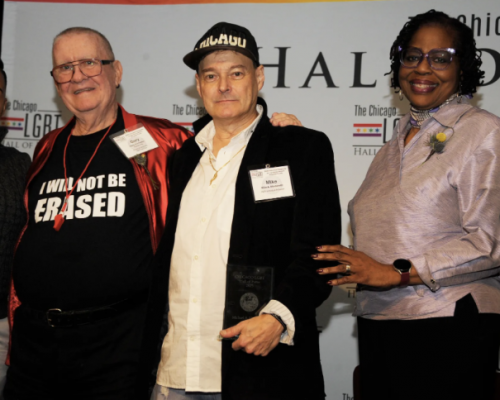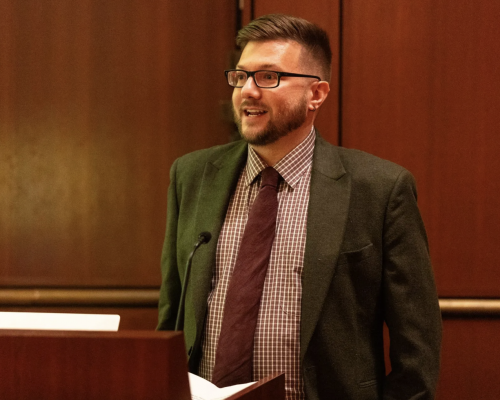TOP STORY: Print still rules: 18th annual Gay Press Report shows that the news for the LGBT press is good
by Chuck Colbert
Ad spending is up. Circulation is up. The gay press is growing. But gay-specific ads are down. These are major findings of the recently released 2012 Gay Press Report.
The Gay Press Report, now in its 18th year, tracks all advertising and revenue in the gay press, including local newspapers, local LGBT magazines and guides, and national LGBT magazines. It has been published annually since 1994.
“The gay press is fully recovered from the recession,” said Todd Evans, president and CEO of Rivendell Media, the nation’s largest LGBT ad placement firm. (Rivendell is also publisher of Press Pass Q.)
“LGBT Press, once thought to be recession proof, was dramatically affected by the 2009 recession,” Evans said. “Spending, which had been always trending up — sometimes dramatically — showed wide swings from its all-time high in 2009 to almost a 50 percent spending loss in 2010 back to another wide swing up in 2011 and is again approaching its all-time high.”
In all, ad spending in LGBT media for 2012 is $322.6 million — a 5.1 percent increase from 2011, according to findings in the 23-page document, which was published by Rivendell in June. Ad revenue for 2011 stood at $307 million, but the all-time high was $349.6 million in 2009.
By way of comparison, spending for general market consumer magazines registered slight declines of 1.3 percent (2011) and 3.0 percent (2012) after a slight recovery in 2010. Revenues in the general market category for 2012 are estimated at $10.4 billion, compared to a high of $14.1 billion in 2007, which is 25.7 percent drop.
Overall, “since 1996,” the report states, “gay press revenues have increased 340.1 percent compared to general market consumer magazines,” which “translates into compound annual growth rates of 9.7 percent and 1.0 percent respectively.” That means “from 1996 to 2012, ad revenues for gay press grew almost 10 times faster than” the general market category.
“This report shows the LGBT press outperforming general magazine spending growth in 2012,” said Tracy Baim, publisher and executive editor of Chicago-based Windy City Times. “In this ever-changing media landscape, it is important for companies to focus their money in targeted ways, and the LGBT community provides a better value for their spending dollars than almost any media company. LGBTs are trend leaders, and their regional media outlets provide an excellent opportunity to reach a valued and valuable community. These media companies have a long history as legacy media outlets in their cities, and the level of their connection to their communities is not able to be duplicated through any other advertising channels.”
Other report findings showed that circulation of LGBT media is also up nearly five percent, with the combined circulation of all LGBT media for 2012 at 2,341,337.
The number of gay publications is also up seven percent, with the number of titles in gay media rising from 114 in 2011 to 122 in 2012. The same year the gay press consisted of 205 issues — 26 more than in 2011.
In more good news, a recent informal survey of the leading LGBT publishers, conducted May 31, in anticipation of the Gay Press Report’s release, indicated that 85 percent of respondents are optimistic for a good year ahead.
But not all the news is good. Gay specific ad revenue fell 20.4 percent from 2011. The Gay Press Report does not provide revenue dollar amounts for gay-specific ads, but for some time now the report showed upward trends from 2002 to 2010. In 2002 gay-specific ads accounted for nearly 10 percent of all advertising in LGBT media. By 2010, it had reached an all-time high of 72.4 percent. In 2012, gay-specific ads were 54.2 percent.
Gay specific ads are those that explicitly reference gay and lesbian people and their lives. Creative ads can be topical, for example, dealing with a social issue that is important to the LGBT consumer audience or in their depiction and portrayal of relationships. The theory behind such targeted marketing is that gay consumers favorably respond when they see themselves reflected in advertising.
The Gay Press Report offers an explanation for the downturn: “This decline may be just a leftover effect of the Great Recession. Creative investment is still generally the largest line item cost for any ad campaign and also requires a much longer investment of time. During economic downturns, it is not unusual for companies to continue their existing campaigns or, in LGBT media’s case, run their mainstream campaigns rather than invest in new creative.”
In another important finding, the Gay Press Report showed that local gay media accounts for 95.3 percent of all spending, with local LGBT newspapers accounting for 77.2 percent of revenues, local LGBT guides and magazines 18.1 percent, and national LGBT magazines 4.7 percent.
The Gay Press Report documented a variety of ad categories, including real estate, financial services, health/fitness/grooming, medical/health, arts and entertainment, travel, food and beverage, events, retail, home furnishing/décor, automotive, gay internet sites, and professional services, among others.
The report showed a number of noteworthy increases in some categories such as events, home, retail, real estate, and fashion/accessories, with other categories remaining about the same or notably lower.
In the gay-specific category, only events (gay events, meetings, AIDS events/fundraisers) and retail showed increases in spending for advertising. Other categories showed declines.
The Gay Press Report provides a unique, historical perspective on the gay and lesbian market. The report includes all publications that specifically and exclusively target the LGBT market and include publications regardless of representation by Rivendell. All titles are gathered from the month of April insofar as it is considered an average month in the gay media cycle. All advertising is then categorized, measured and tracked. The information is extrapolated for all 12 months of the calendar year.
The importance of this methodology cannot be overstated, according to Rivendell’s Evans. “We track every LGBT publication that is known, and it takes an enormous amount of effort as so many publications will not send us their April issue if we do not have an ad in them. But we would gladly pay for the issue,” he explained.
“I think one of the biggest crises in gay media is that there is not much news about the gay press or the LGBT market while there is plenty of news about equal rights. Then, of course, we have the whole world of digital media saying print is dead. This report is virtually the only tool promoting the LGBT market showing actual ad spending,” said Evans. “One thing is clear: Print is where most money is spent in the LGBT market. Print still rules. This report helps to stimulate interest by Madison Avenue.”
The full report is available at: http://www.rivendellmedia.com/documents/2012gaypressreport.pdf
TOP STORY: Making Pride fresh: Editors and publishers find ways of putting new twists on annual coverage
by Chuck Colbert
The season of LGBT Pride has arrived, with parades and festivals and whole lot more bursting out all over this June and beyond. For more than four decades now, gay Americans from coast to coast have celebrated LGBT rights and liberation. As each locality develops its schedule of events, a certain routine of parades and après-parade festivities set in. How then do gay media outlets keep their coverage interesting and fresh?
Press Pass Q asked editors and publishers from six metropolitan areas, including Boston, Chicago, Philadelphia, San Diego, San Francisco, and Washington, D.C. Here is a sampling of how their LGBT media outlets cover the annual summer rites:
“For the last six years, we have tried to explore a larger theme, explore a larger question in each Pride issue,” said Kevin Naff, editor of the Washington Blade, where the District of Columbia held its parade on Saturday, June 8.
In light of all the good news lately, namely the 2102 election results and the advance of marriage equality in Delaware, Minnesota, and Rhode Island, the Blade posed this question to politicians, celebrities, bloggers and movement leaders: “Have we reached a turning point in the LGBT rights movement and what does the end of the movement look like to you?”
Responses from 20 celebrities, like singer Melissa Etheridge and Oakland Raiders ally Chris Kluwe, were published over six pages in the Blade’s Pride issue. A consensus from respondents suggested that while we’re not at end of the movement, at least a turning point has been reached, one from which there is no turning back.
For his part, Naff’s editorial “End of the Rainbow?” pointed to the lack of workplace protections in many states, rising rates of HIV infection among MSM, and hate crimes targeting LGBTs as examples of remaining problems that need to be addressed.
Of course, the Blade covered the District’s parade and street festival, along with a schedule of events and logistics. The publication also reported on Baltimore Pride the following week. The Blade is also a sponsor of New York City Pride on Sunday, June 30.
Just as parade participants trekked the streets of the nation’s capital, so marchers traveled through Boston. Both cities held their major celebrations on the same day.
Boston-based Rainbow Times’ editor Nicole Lashomb said the key to keeping the publication’s Pride coverage interesting is cooperation or “a partnership” between the newspaper and event organizers.
“The organizations are responsible for putting together the events that will attract the community and therefore make interesting coverage for the publication,” she explained. For its part, “The Rainbow Times provides extensive photo and story coverage that appears digitally in our social media platform, including Facebook, Twitter, Pinterest, Stumble Upon, Tumblr and our website within 24 hours.”
The Rainbow Times also provides coverage of other Pride celebrations in the New England region. “We are proud to call ourselves the only LGBT New England publication that has such a comprehensive coverage of Boston Pride and beyond both online and in print,” she said.
Rainbow Times publisher Gricel Martinez Ocasio said that it is important to keep in mind that “Pride coverage is evolving,” adding, “Because of that, we now publish two different Pride pieces, one pocket-size New England Pride Map, expandable to an 11×17 glossy piece that acts as a portable quick reference to all of the critical event information taking place during Pride season.
“The second publication is the Boston Pride Guide. This guide is specific to Boston Pride and contains elaborated information regarding Pride week and the events taking place during that time. The Rainbow Times, every year through the Boston Pride Guide, highlights some of the feature performers via exclusive interviews. Our motto is: Interested attendees may be more attracted to the events taking place if they know more about the performers.”
“We also we partner with most of the New England Pride organizations to allow for optimal exposure of their events online and in print,” said Ocasio.
Philadelphia Pride was Sunday, June 9. Philadelphia Gay News (PGN) editor Jen Colletta spoke to the task of keeping coverage fresh each year. “It definitely is challenging for PGN to find new and interesting angles to cover each year. When writing a preview story about Philly’s Pride event, we always try to focus on what’s new — a new event, new location, new party — to show what sets this year’s Pride apart from last year’s or the year before.”
“If there’s nothing new that’s interesting enough to base a story around, we have also focused on some new trends,” Colletta said. “For example, recently Pride organizers have begun noticing an influx in younger attendees, so we focused one story on that aspect. We have also done pieces on the financial and logistical challenges of Pride. For arts coverage, we interview the headlining entertainer each year as well as performers with great background stories or who are new to the event.
“We also focus heavily on our photographic coverage, featuring a special post-Pride pullout section the following week that’s filled with pictures. We try to use the photos to tell the story of that year’s Pride, and we’ve found that people really enjoy getting to see that visual recap, as well as possibly seeing themselves or their friends in print.”
In Chicago, the Pride landscape has an interesting twist, said Windy City Times publisher and executive editor Tracy Baim. There, the Pride organization does the parade and nothing else. “The extracurricular activities are privately-sponsored, with a different motive,” that of “profit. Therefore, there’s a little more variety in what goes on — not a lot of entrenched stuff.”
Baim pointed to the Northalstead Business Alliance as an example of one organization, which for several years sponsored a street festival the day before Sunday’s parade. But this year, she said, the festival has been moved up a week before Pride and expanded to both Saturday and Sunday.
For its part, Windy City Times sponsors a “Gay Idols” contest each year, with the winner crowned in the Pride issue, said Baim. In addition, the publication spotlights 30 LGBTs under 30 years of age. The winners are announced in the Pride issue.
These events, while routine, said Baim, always inject “new energy and new people” into the celebration and coverage.
“We do the routine stuff,” said Baim, “take and run photos. But there is enough going on in the community, so we feel we can cover some of the ongoing and some of the one-time events. Our Pride issue and the post-Pride issue are our largest, and everyone knows to save them as souvenirs because there is so much in it.”
Baim also said that because the Metropolitan Community Church’s General Conference is scheduled the week after Pride, this year’s Pride issue will have a focus on religion.
Of course, the U.S. Supreme Court’s pending rulings on Proposition 8 and the Defense of Marriage Act are on the minds of many. Those decisions are expected before Chicago Pride and “will greatly influence what happens,” said Baim and by “what happened in [the Illinois capital of] Springfield” the last week of May when the General Assembly adjourned without taking a vote on the same-sex marriage bill passed by the state Senate.
Chicago’s Pride parade is Sunday, June 30.
Not all Pride celebrations occur in June. For example, this year’s San Diego LGBT Pride, held July 12-14, marks its 39th annual celebration. The San Diego Pride organization produces the annual parade, festival and celebration, and also coordinates a number of advocacy, civil rights and community service activities year round, said Steve Lee, editor of San Diego LGBT Weekly.
In a word, the publication’s handling of Pride is comprehensive. San Diego LGBT Weekly covers not only Pride season, but also San Diego Pride. “In our most recent print issue, we ran a two-page feature on ‘Pride Season’ where we profiled upcoming Pride Festivals in California,” said Lee. “Ahead of the main festival newsworthy items concerning San Diego Pride are covered in print and in daily updates on our website LGBTweekly.com.”
Besides Pride news coverage in its biweekly print magazine, the publication also produces a separate Pride Guide, both coming out the day before the festival starts.
“The Pride Guide gives locals and visitors alike all the nuts and bolts of the three-day festival including community events, club events, festival entertainment schedules and a map,” Lee explained. “The content of the main magazine is also geared to serve the needs of both locals and visitors to the city. This 64-plus-page issue has a special cover and in addition to our regular columnists is packed with special features, guest commentaries and hyper-local content. We may consider joint promotions, giveaways and competitions.
“We profile and interview the headlining entertainment acts. This year we are also profiling the main Pride party’s producer. We run features on local LGBT leaders and politicians. We cover health and entertainment. Additionally, we include plenty of information for visitors to San Diego from places to go beyond the festival to downtown restaurant and nightlife guides,” he explained. “A week after Pride, we publish a special glossy four-page pullout within the main magazine this year called ‘2013 Pride Yearbook,’ containing pictures of every aspect of San Diego Pride.”
Sure enough, Pride-related controversy is guaranteed to spice up coverage. Take what Bay Area Reporter (BAR) news editor Cynthia Laird referred to as the “Bradley Manning fiasco,” which “has been at the center of our Pride coverage since early May,” she said.
U.S. Army Private Manning is the WikiLeaks whistle-blower who pleaded guilty to releasing classified documents.
Early on, said Laird, reaction to his being selected as grand marshal was positive. But when “gay military folks took to Facebook to express their displeasure at the selection, I knew then that we had a story. The Pride board rescinded his grand marshal honor late Friday, April 26. We editorialized right away for the board to reinstate Manning, because to us, once you bestow something like a grand marshal honor you can’t take it away.
“Most of the negative reaction to the Pride board has been of its own making. There seemed to be process problems within Pride over the group — former grand marshals — that voted on the Manning selection. Pride has many grand marshals, some chosen by the public, some by Pride members. Pride came out with not one, but two clumsy news releases that further angered people. Then, the board tried to block media access from a meeting. Our reporter was allowed in but our photographer was not. So, as they say in the news biz, it’s the story that keeps on giving.”
More recently, Pride organizers announced on June 7 that Manning would not receive any honor or recognition.
“I imagine this will be an issue through the parade, as we see what the Bradley Manning contingent will do. I suspect the contingent will be larger than the past two years, and much more vocal,” said Laird.
This year’s Pride theme is “Embrace, Encourage, Empower.” BAR’s special section will focus on grand marshal profiles and stories related to the theme of empowerment, said Laird. “And our news section for June 27 will have the latest on Pride and safety measures in the wake of Boston Marathon bombings.”
Volume 15
Issue 3
TOP STORIES






